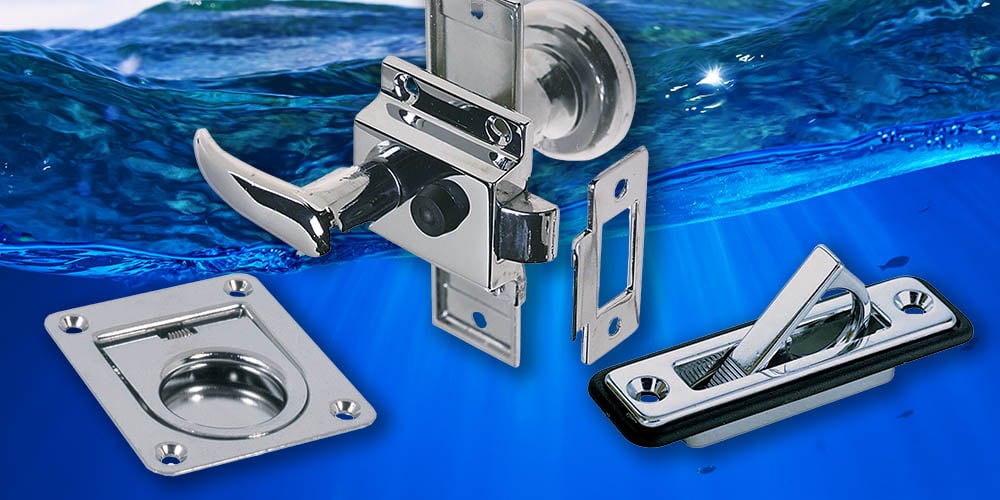
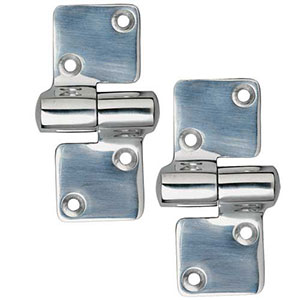
Take-apart hinges are ideal for engine covers and lift off hatches because they can quickly be separated without tools.
Marine cabinet hardware includes all of the little metal stuff that allows you to build boat cabinetry. Most of these items are smaller than household items, and made from corrosion-resistant materials like brass, chrome plated brass, or stainless steel.
Padlocks
Marine locks are very similar to steel locks used on land except that they are generally corrosion resistant and made from brass or bronze.
A common option is to have keyed alike locks so that all lockers in the cockpit, the dock box, and the companionways can all use the same key. It is also common for the boat in the next slip to have the same locks. We also stock some door hardware with built-in locks. They include a doorknob and catch, and are either set into the door or mounted on the surface of the door. They are made of chrome-plated brass and look like they belong on a boat.
Hinges
There are many hinges to select from, and the function of a hinge should be obvious. Several are unique and noteworthy:
- Piano hinges are long, continuous lengths of material that are good for tables, hatches, dock boxes, and anywhere where two long surfaces meet.
- Take-apart hinges have a removable hinge pin that is spring loaded, so the two hinged items can be disconnected easily. These can be used on a companionway ladder, for example, that needs to swing up or be completely removed.
- Offset hinges have one side larger than the other, with a right angle built-in. When the hinge is opened all the way, the two sides are not flush with each other, so the hinge can be opened wide without binding on itself.
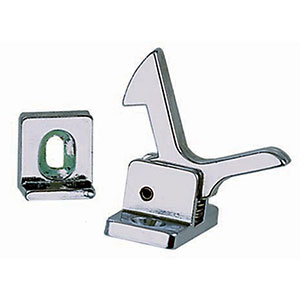
Zinc Elbow Catch
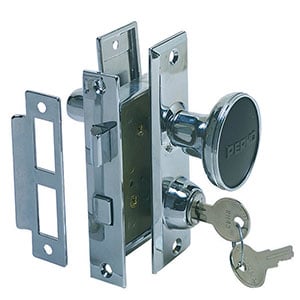
Mortise Latch Set with inside deadbolt lock
Product Selection: Other Hardware
Finally, there is a great deal of cabin hardware used in a variety of applications onboard.
Catches are used to secure cupboard or locker doors. They consist of two parts: a latch or pin (on the door), which snaps into a receptacle or socket (on the doorframe). Their snap-in/snap-out nature makes them less secure relative to latches, bolts, or hooks.
Hasps have a hinged plate with a slot that fits over a raised eye. When the plate is folded over the eye, it can accommodate a padlock and secure a hatch, door, or locker.
Door hooks consist of a hook and an eye, and are used to hold doors closed and to keep an open door from banging around.
Door latches include a knob and a catch, and help keep cabin doors secure. There are several variations on this concept:
- Rim latch/lock sets are mounted on the surface of the door.
- Mortise latch/lock sets are set into the door.
- The strike is the plate installed on the doorjamb that has a hole to accept the latch when it is extended. Box strikes mount on the surface of the doorframe. Flush strikes are inset into the doorframe.
- The case is the housing for the lock and/or latch. The escutcheon is the decorative plate mounted on the exterior side of the door.
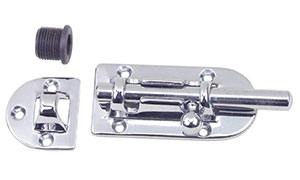
This barrel bolt has a friction pad for smooth operation and to reduce rattling.
Barrel bolts consist of two parts: a sliding bar that attaches to the door and a receptacle that attaches to the doorframe. When the bolt slides into the receptacle, it creates a very secure closure, as the bar is held captive and cannot slide out accidentally.
Corner braces are the nautical equivalent of L-brackets, and are used to help suspend tables, counters, and other platforms at a right angle to the mounting surface.
Table brackets are similar to corner braces, but they consist of two pieces so the suspended object (most likely a table) can be removed if necessary.
Handles and Pulls
Depending on the application, some handles will work better than others. Flush mount pulls are great, especially in cramped spaces, because you won't have to worry about them snagging gear or your clothing as you walk by.
Doorknobs are through-bolted or screwed into doors or drawers to help get them open.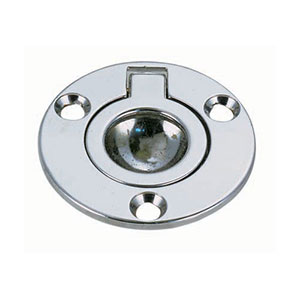
Many ring pulls mount flush with the surface of the cabinet to eliminate the change of snagging something on them and can be opened with only one finger.
Flush handles have a hinged handle that falls flat into a recessed base when not in use, so that the surface is flush when it is not in use. The lack of a projecting handle prevents gear and/or people from getting snagged.
Ring pulls are similar to flush handles, but they consist of simply a small hinged ring rather than a substantial handle. They are used to open small compartments only.
Most items in this category are considered light-duty closures, and are suitable for securing interior doors, cabinets, etc. Most (with the possible exception of hasps and some grab handles) should not be considered for external doors where security is a consideration. All are sized to handle modest loads and secure relatively lightweight objects. Make sure you do not overestimate the capacity of these fastenings.